User Assessment of a Customized Taekwondo Athlete Performance Cyber–Physical System
Abstract
:1. Introduction
2. Methodology
2.1. Studies on Performance Analysis in Sport
2.2. The SPERTA System
3. Study on the System’s Acceptability
3.1. System Data Collection
- Convolutional neural networks (CNNs) are feedforward neural networks that use filters and pooling layers and do not have recurrent connections. They are suitable for working with images and videos, for example for facial recognition, medical analysis, and image classification [37].
- Recurrent neural networks (RNNs) are a type of artificial neural network used to analyze time series data; they use recurrent connections to generate output. They are suitable for speech recognition, natural language processing, and tasks such as text summarization, machine translation, and speech analysis. RNNs, due to their architecture, can suffer from problems such as gradient disappearance and explosion [38].
- Long–short-term memory (LSTM) networks are a type of RNN with greater memory power to remember the outputs of each node for a longer period, thus combating the disappearance of gradients or the long-term dependency problem of RNNs. LSTM networks have gates that update and regulate cell states, such as the forget gate, which determines what information in the cell state should be forgotten, helping RNNs remember the critical inputs needed to generate the correct output [39].
3.2. System Acceptability Survey
4. Results
5. Discussion
6. Conclusions and Future Work
Author Contributions
Funding
Institutional Review Board Statement
Informed Consent Statement
Data Availability Statement
Acknowledgments
Conflicts of Interest
References
- Shahabuddin, S.M.; Prasanth, Y. Integration testing prior to unit testing: A paradigm shift in object oriented software testing of agile software engineering. Indian J. Sci. Technol. 2016, 9. [Google Scholar] [CrossRef]
- Greer, C.; Burns, M.; Wollman, D.; Griffor, E. Cyber-Physical Systems and Internet of Things; National Institute of Standards and Technology: Gaithersburg, MD, USA, 2019. [CrossRef]
- Theis, T.N.; Wong, H.-S.P. The End of Moore’s Law: A New Beginning for Information Technology. Comput. Sci. Eng. 2017, 19, 41–50. [Google Scholar] [CrossRef]
- South Korea’s National Sport: Taekwondo (7 Facts). Available online: https://sportsfoundation.org/south-korea-national-sport/ (accessed on 29 January 2024).
- Ko, Y.J.; Kil Kim, M.; Kim, Y.K.; Lee, J.-H.; Cattani, K. Consumer satisfaction and event quality perception: A case of US Open Taekwondo Championship. Event Manag. 2010, 14, 205–214. [Google Scholar] [CrossRef]
- Cunha, P.; Barbosa, P.; Ferreira, F.; Fitas, C.; Carvalho, V.; Soares, F. Real-time evaluation system for top taekwondo athletes: Project overview. In Proceedings of the BIODEVICES 2021—14th International Conference on Biomedical Electronics and Devices, Part of the 14th International Joint Conference on Biomedical Engineering Systems and Technologies, BIOSTEC 2021, Online, 11–13 February 2021; pp. 209–220. [Google Scholar] [CrossRef]
- Arnold, R.D.; Wade, J.P. A Definition of Systems Thinking: A Systems Approach. Procedia Comput. Sci. 2015, 44, 669–678. [Google Scholar] [CrossRef]
- Aggarwal, J.; Cai, Q. Human Motion Analysis: A Review. Comput. Vis. Image Underst. 1999, 73, 428–440. [Google Scholar] [CrossRef]
- Mrabti, W.; Baibai, K.; Bellach, B.; Thami, R.O.H.; Tairi, H. Human motion tracking: A comparative study. Procedia Comput. Sci. 2019, 148, 145–153. [Google Scholar] [CrossRef]
- Faisal, A.I.; Majumder, S.; Mondal, T.; Cowan, D.; Naseh, S.; Deen, M.J. Monitoring Methods of Human Body Joints: State-of-the-Art and Research Challenges. Sensors 2019, 19, 2629. [Google Scholar] [CrossRef] [PubMed]
- D’isanto, T.; Campania, I.M.; D’elia, F.; Raiola, G.; Altavilla, G. Assessment of sport performance: Theoretical aspects and practical indications. Sport Mont 2019, 17, 79–82. [Google Scholar] [CrossRef]
- Cossich, V.R.A.; Carlgren, D.; Holash, R.J.; Katz, L. Technological Breakthroughs in Sport: Current Practice and Future Potential of Artificial Intelligence, Virtual Reality, Augmented Reality, and Modern Data Visualization in Performance Analysis. Appl. Sci. 2023, 13, 12965. [Google Scholar] [CrossRef]
- Shih, H.C. A Survey on Content-Aware Video Analysis for Sports. IEEE Trans. Circuits Syst. Video Technol. 2017, 28, 1212–1231. Available online: https://ieeexplore.ieee.org/stamp/stamp.jsp?arnumber=7827117 (accessed on 6 May 2024). [CrossRef]
- Wu, F.; Wang, Q.; Bian, J.; Ding, N.; Lu, F.; Cheng, J.; Dou, D.; Xiong, H. A Survey on Video Action Recognition in Sports: Datasets, Methods and Applications. IEEE Trans. Multimedia 2022, 25, 7943–7966. [Google Scholar] [CrossRef]
- Morikawa, C.; Kobayashi, M.; Satoh, M.; Kuroda, Y.; Inomata, T.; Matsuo, H.; Miura, T.; Hilaga, M. Image and video processing on mobile devices: A survey. Vis. Comput. 2021, 37, 2931–2949. [Google Scholar] [CrossRef] [PubMed]
- May, S.; Pervoelz, K.; Surm, H. 3D Cameras: 3D Computer Vision of Wide Scope. In Vision Systems: Applications; I-TECH: Vienna, Austria, 2007. [Google Scholar] [CrossRef]
- Kinect para Windows—Windows Apps|Microsoft Learn. Available online: https://learn.microsoft.com/pt-pt/windows/apps/design/devices/kinect-for-windows (accessed on 24 November 2022).
- Zerpa, C.; Lees, C.; Patel, P.; Pryzsucha, E. The Use of Microsoft Kinect for Human Movement Analysis. Int. J. Sports Sci. 2015, 5, 120–127. [Google Scholar] [CrossRef]
- Patsadu, O.; Nukoolkit, C.; Watanapa, B. Human gesture recognition using Kinect camera. In Proceedings of the JCSSE 2012—9th International Joint Conference on Computer Science and Software Engineering, Bangkok, Thailand, 30 May–1 June 2012; pp. 28–32. [Google Scholar] [CrossRef]
- Pinto, T.; Faria, E.; Cunha, P.; Soares, F.; Carvalho, V.; Carvalho, H. Recording of occurrences through image processing in Taekwondo training: First insights. In Proceedings of the VI ECCOMAS Thematic Conference on Computational Vision and Medical Image Processing (VipIMAGE 2017), Porto, Portugal, 18–20 October 2017; Lecture Notes in Computational Vision and Biomechanics. Springer: Cham, Switzerland, 2018; Volume 27, pp. 427–436. [Google Scholar] [CrossRef]
- Cunha, P.; Carvalho, V.; Soares, F. Development of a Real-Time Evaluation System for Top Taekwondo Athletes SPERTA. In Proceedings of the SENSORDEVICES 2018: The Ninth International Conference on Sensor Device Technologies and Applications, Venice, Italy, 16–20 September 2018. [Google Scholar]
- Lun, R.; Zhao, W. A Survey of Applications and Human Motion Recognition with Microsoft Kinect. Int. J. Pattern Recognit. Artif. Intell. 2015, 29, 1555008. [Google Scholar] [CrossRef]
- Robertson, D.G.E.; Caldwell, G.E.; Hamill, J.; Kamen, G.; Whittlesey, S. Research Methods in Biomechanics; Human Kinetics: Champaign, IL, USA, 2013; Available online: https://books.google.pt/books?hl=pt-PT&lr=&id=_u56DwAAQBAJ&oi=fnd&pg=PR1&dq=Research+Methods+in+Biomechanics&ots=ConkQFLtgN&sig=riVY54GFRMkgP43XWHZ5ZM8RqZw&redir_esc=y#v=onepage&q=Research%20Methods%20in%20Biomechanics&f=false (accessed on 24 November 2022).
- Corazza, S.; Mündermann, L.; Gambaretto, E.; Ferrigno, G.; Andriacchi, T.P. Markerless Motion Capture through Visual Hull, Articulated ICP and Subject Specific Model Generation. Int. J. Comput. Vis. 2009, 87, 156–169. [Google Scholar] [CrossRef]
- Huang, X.; Xue, Y.; Ren, S.; Wang, F. Sensor-Based Wearable Systems for Monitoring Human Motion and Posture: A Review. Sensors 2023, 23, 9047. [Google Scholar] [CrossRef] [PubMed]
- Li, R.T.; Kling, S.R.; Salata, M.J.; Cupp, S.A.; Sheehan, J.; Voos, J.E. Wearable Performance Devices in Sports Medicine. Sports Health 2015, 8, 74–78. [Google Scholar] [CrossRef] [PubMed]
- Suarez, J.; Murphy, R.R. Hand gesture recognition with depth images: A review. In Proceedings of the IEEE International Workshop on Robot and Human Interactive Communication, Paris, France, 9–13 September 2012; pp. 411–417. [Google Scholar] [CrossRef]
- Camomilla, V.; Bergamini, E.; Fantozzi, S.; Vannozzi, G. Trends Supporting the In-Field Use of Wearable Inertial Sensors for Sport Performance Evaluation: A Systematic Review. Sensors 2018, 18, 873. [Google Scholar] [CrossRef]
- Mendes, J.J.A.; Vieira, M.E.M.; Pires, M.B.; Stevan, S.L. Sensor Fusion and Smart Sensor in Sports and Biomedical Applications. Sensors 2016, 16, 1569. [Google Scholar] [CrossRef]
- Liu, L.; Yang, J.; Lin, Y.; Zhang, P.; Zhang, L. 3D human pose estimation with single image and inertial measurement unit (IMU) sequence. Pattern Recognit. 2024, 149, 110175. [Google Scholar] [CrossRef]
- Amaro, B.; Antunes, J.; Cunha, P.; Soares, F.; Carvalho, V.; Carvalho, H. Monitoring of bioelectrical and biomechanical signals in Taekwondo training: First insights. In Proceedings of the VI ECCOMAS Thematic Conference on Computational Vision and Medical Image Processing (VipIMAGE 2017), Porto, Portugal, 18–20 October 2017; Lecture Notes in Computational Vision and Biomechanics. Springer: Cham, Switzerland, 2018; Volume 27, pp. 417–426. [Google Scholar] [CrossRef]
- Astra|Orbbec 3D. Available online: https://shop.orbbec3d.com/Astra (accessed on 8 November 2023).
- Operating System Market Share Portugal|Statcounter Global Stats. Available online: https://gs.statcounter.com/os-market-share/all/portugal (accessed on 30 November 2022).
- LOLIN D1 Mini v3.1.0—WEMOS Documentation. Available online: https://www.wemos.cc/en/latest/d1/d1_mini_3.1.0.html (accessed on 24 November 2022).
- MPU6050 Module Pinout, Configuration, Features, Arduino Interfacing & Datasheet. Available online: https://components101.com/sensors/mpu6050-module (accessed on 24 November 2022).
- General Data Protection Regulation (GDPR)—Official Legal Text. Available online: https://gdpr-info.eu/ (accessed on 29 November 2023).
- Alzubaidi, L.; Zhang, J.; Humaidi, A.J.; Al-Dujaili, A.; Duan, Y.; Al-Shamma, O.; Santamaria, J.; Fadhel, M.A.; Al-Amidie, M.; Farhan, L. Review of deep learning: Concepts, CNN architectures, challenges, applications, future directions. J. Big Data 2021, 8, 53. [Google Scholar] [CrossRef]
- Schmidt, R.M. Recurrent Neural Networks (RNNs): A Gentle Introduction and Overview. 23 November 2019. Available online: https://arxiv.org/abs/1912.05911v1 (accessed on 29 January 2024).
- Sherstinsky, A. Fundamentals of Recurrent Neural Network (RNN) and Long Short-Term Memory (LSTM) Network. Phys. D Nonlinear Phenom. 2018, 404, 132306. [Google Scholar] [CrossRef]
- Cunha, P.; Barbosa, P.; Ferreira, F.; Silva, T.; Martins, N.; Soares, F.; Carvalho, V. Cyber-Physical System for Evaluation of Taekwondo Athletes: An Initial Project Description. Machines 2023, 11, 234. [Google Scholar] [CrossRef]
- Usability Testing 101. Available online: https://www.nngroup.com/articles/usability-testing-101/ (accessed on 9 May 2024).
- Usability Testing in Design—Why Is It Important? | by Shree Harsha | UX Collective. Available online: https://uxdesign.cc/usability-testing-in-design-and-why-is-it-important-cfddfbbdaac9 (accessed on 9 May 2024).
- Beyond the NPS: Measuring Perceived Usability with the SUS, NASA-TLX, and the Single Ease Question after Tasks and Usability Tests. Available online: https://www.nngroup.com/articles/measuring-perceived-usability/ (accessed on 9 May 2024).
- Sauro, J.; Lewis, J.R. Correlations among prototypical usability metrics: Evidence for the construct of usability. In Proceedings of the Conference on Human Factors in Computing Systems, Boston, MA, USA, 4–9 April 2019; pp. 1609–1618. [Google Scholar] [CrossRef]
- 5 Ways to Interpret a SUS Score—MeasuringU. Available online: https://measuringu.com/interpret-sus-score/ (accessed on 9 May 2024).
- Lewis, J.R. The System Usability Scale: Past, Present, and Future. Int. J. Hum.–Comput. Interact. 2018, 34, 577–590. [Google Scholar] [CrossRef]
- Tavakol, M.; Dennick, R. Making sense of Cronbach’s alpha. Int. J. Med. Educ. 2011, 2, 53–55. [Google Scholar] [CrossRef]
- Clarke, V.; Braun, V. Thematic analysis. J. Posit. Psychol. 2017, 12, 297–298. [Google Scholar] [CrossRef]
- Nowell, L.S.; Norris, J.M.; White, D.E.; Moules, N.J. Thematic Analysis: Striving to Meet the Trustworthiness Criteria. Int. J. Qual. Methods 2017, 16. [Google Scholar] [CrossRef]
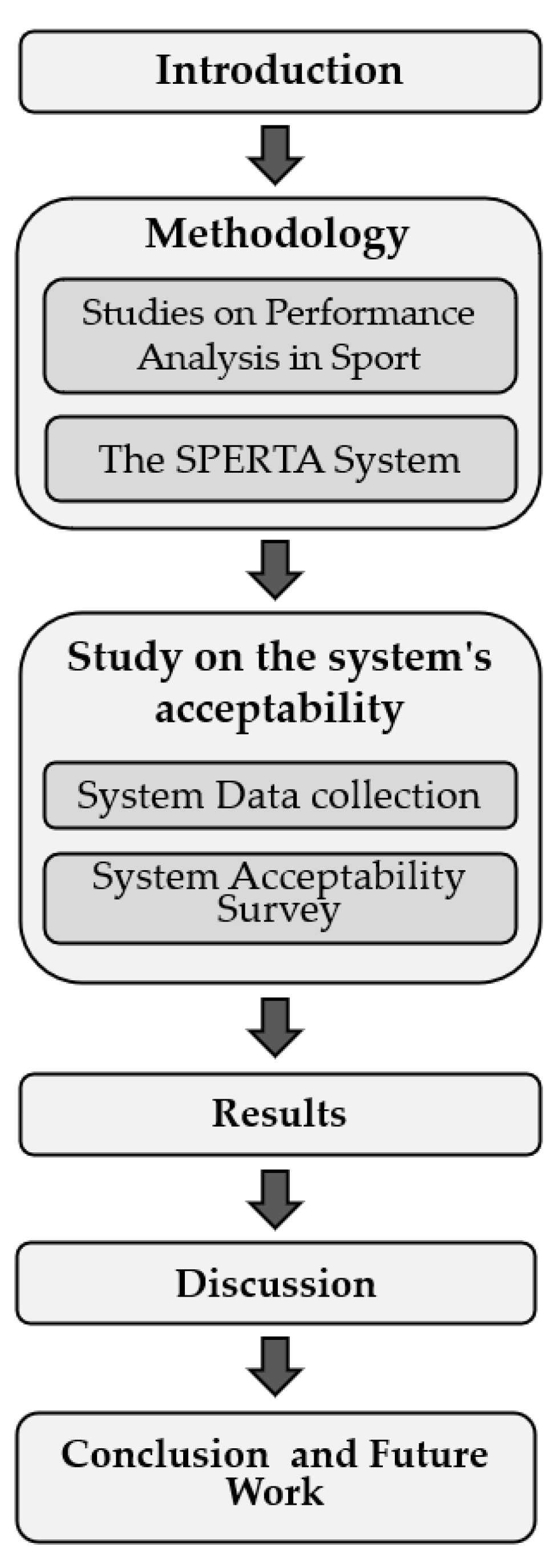
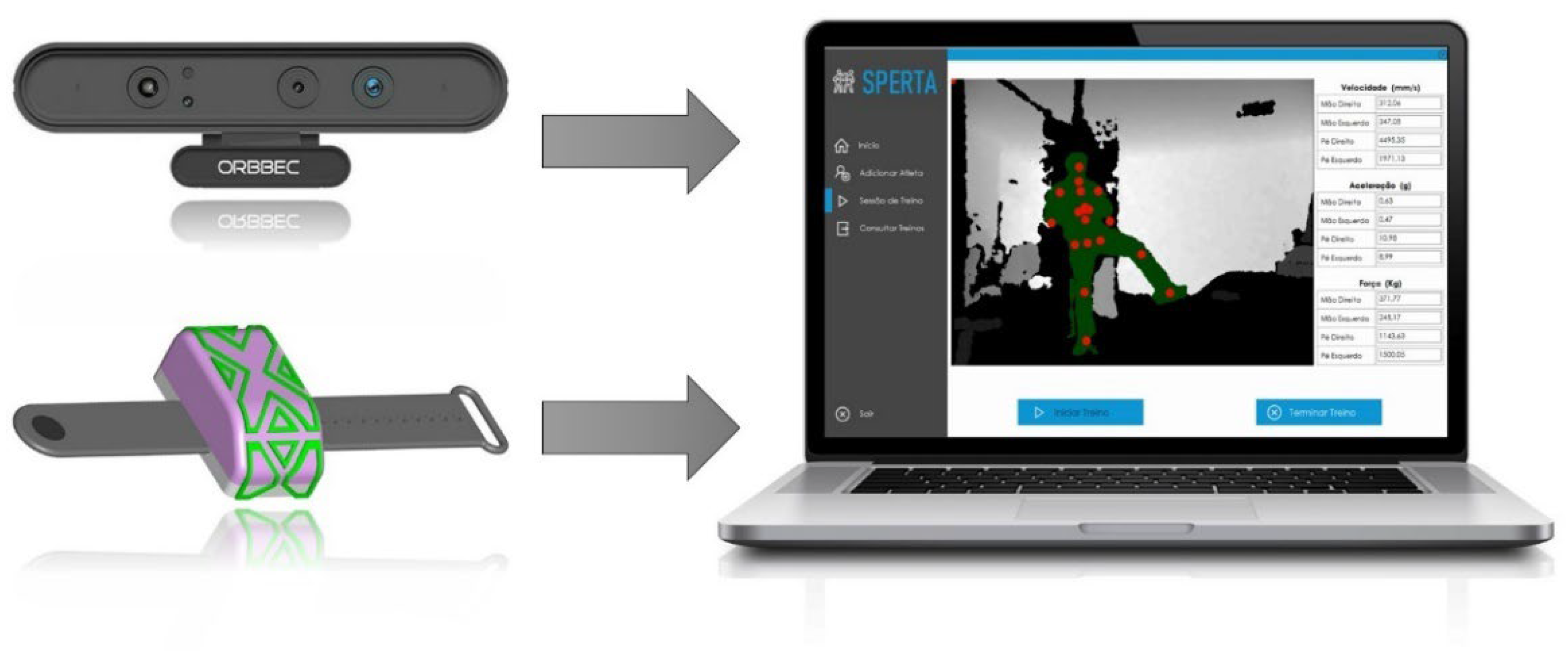
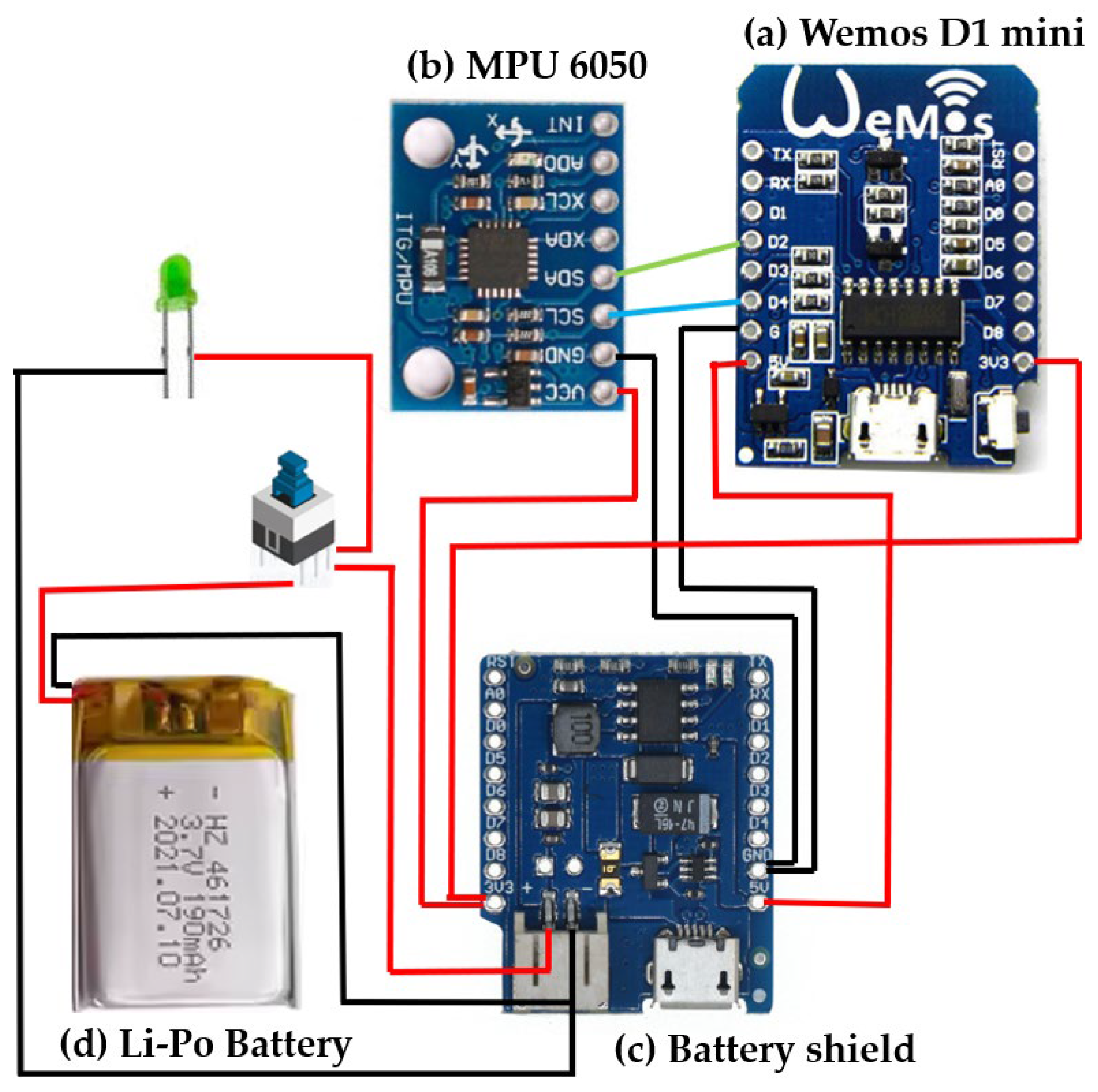
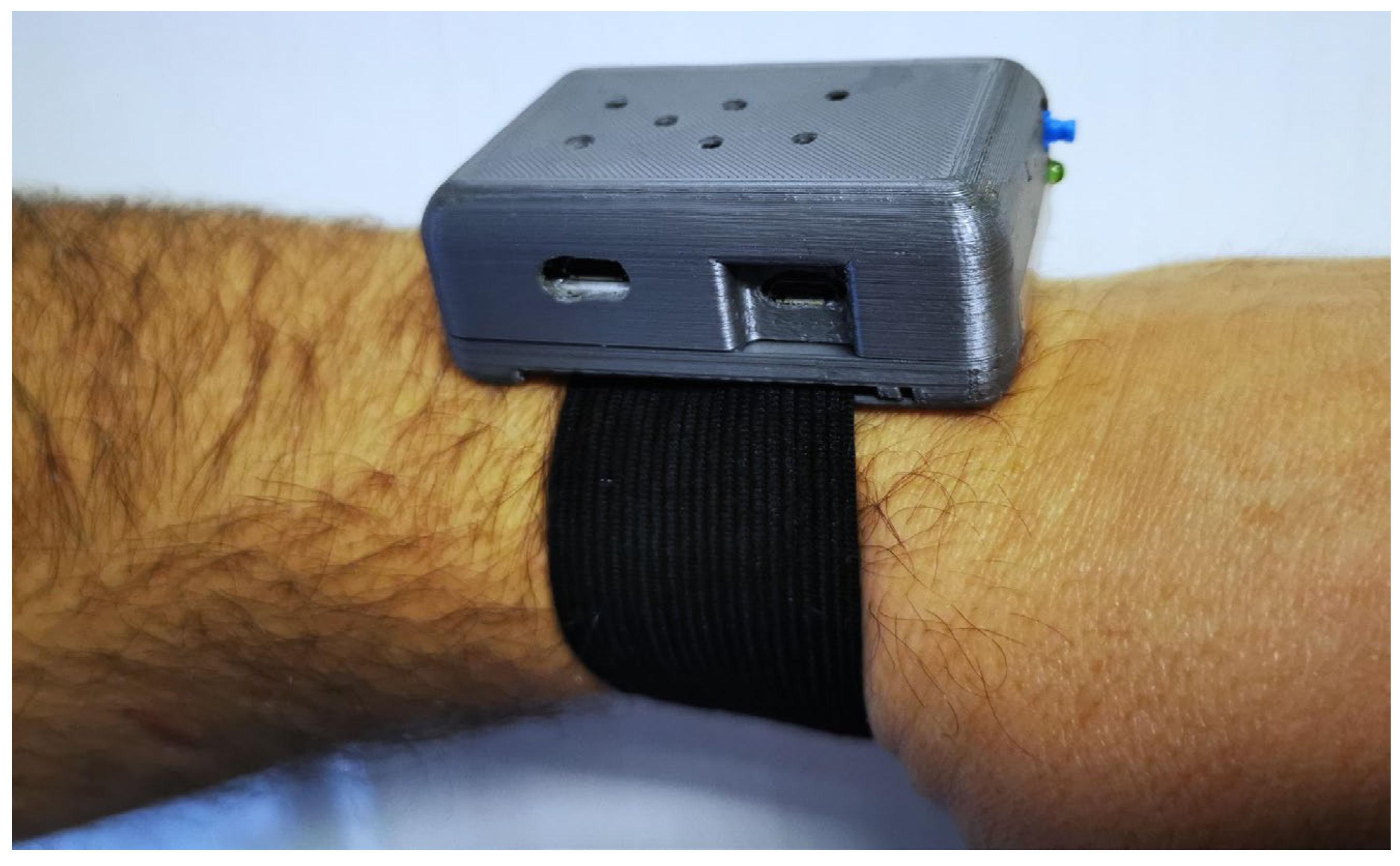
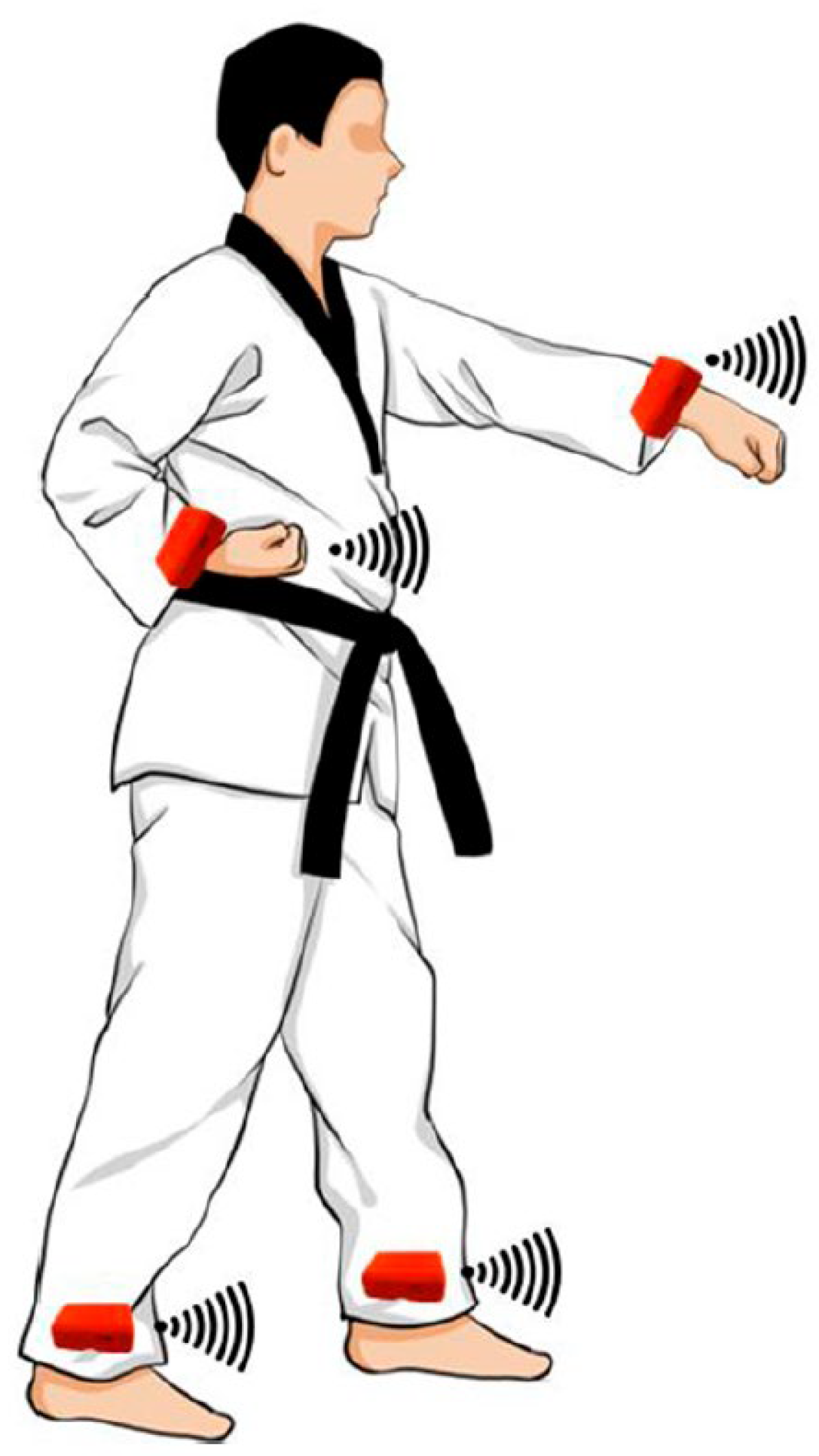
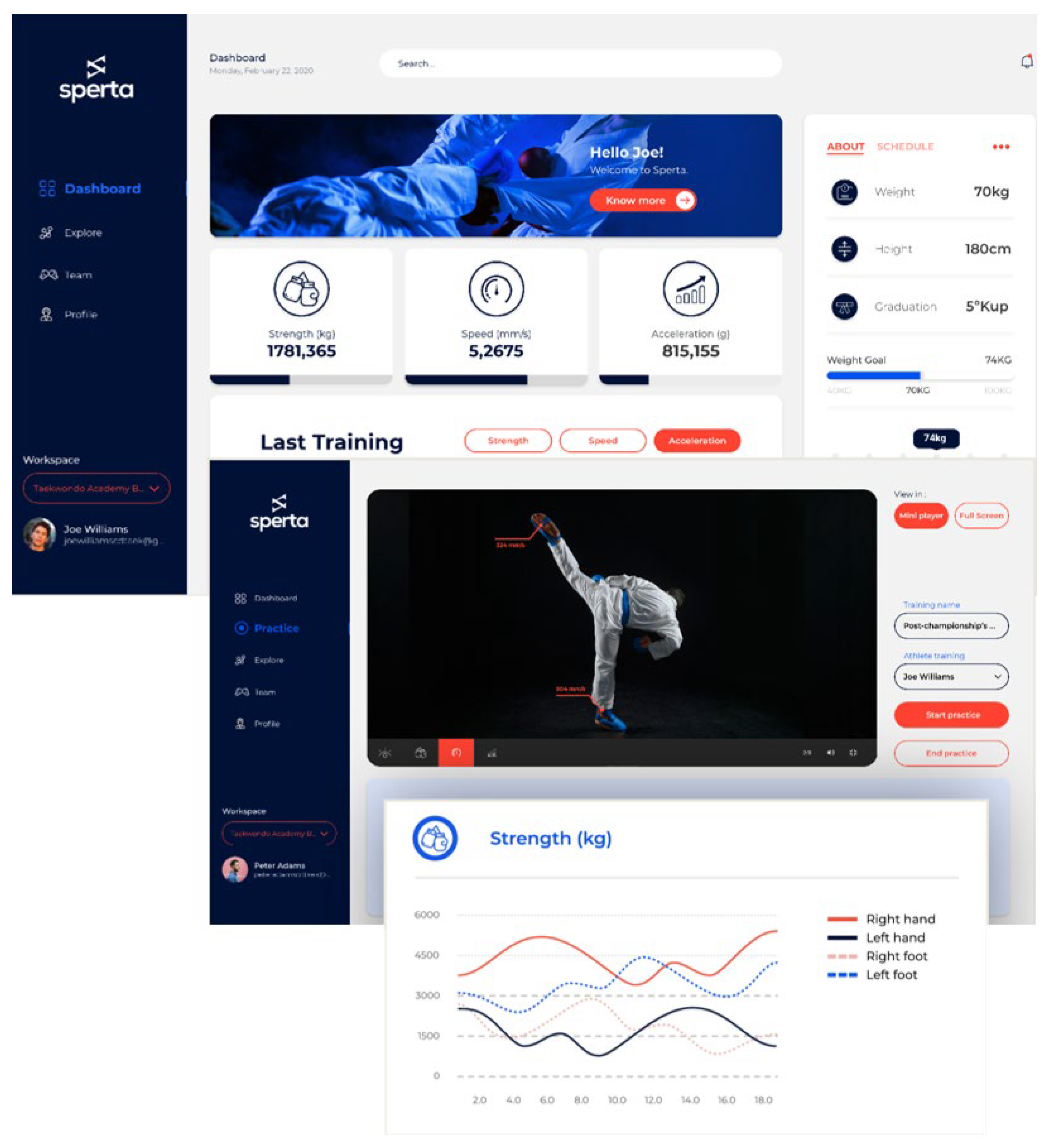



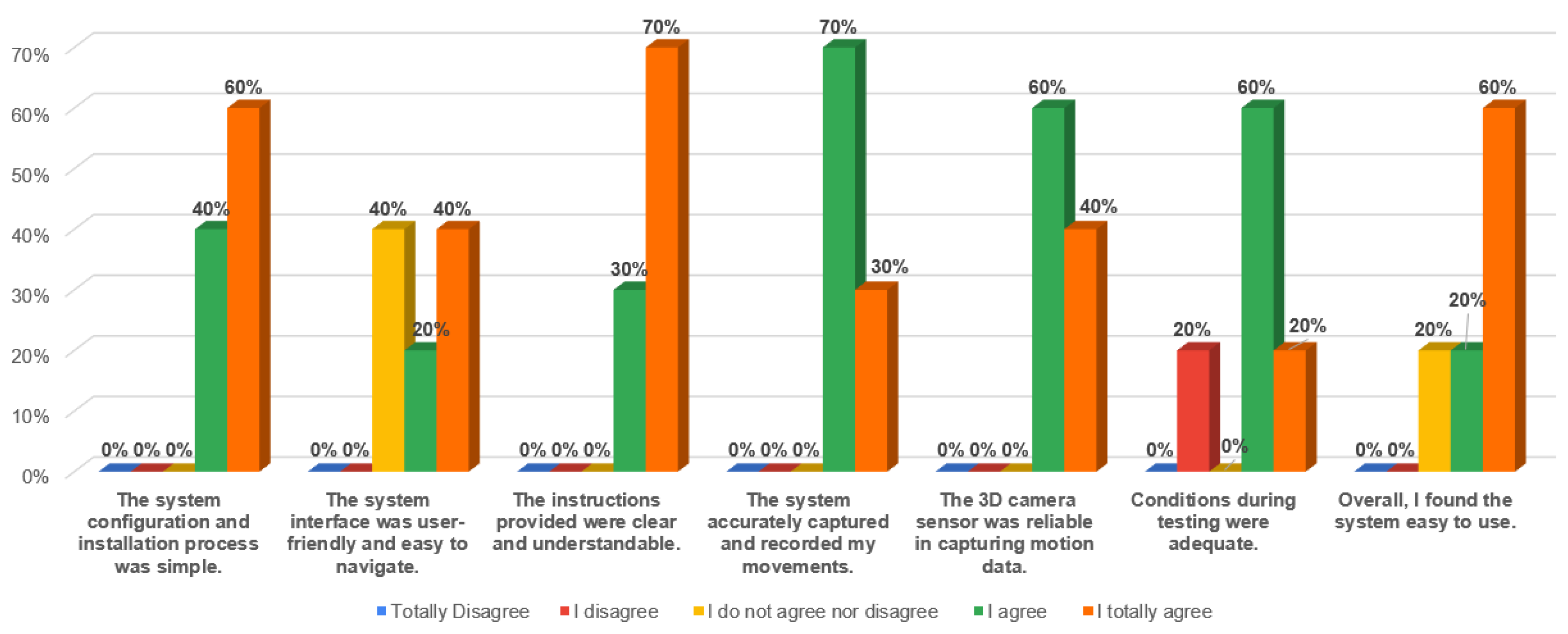

| Jirugui: Frontal punch. |  |
| AP Tchagui: One of the legs in the form of a front kick. |  |
| Bandal Tchagui: Side kick at face height |  |
| Miro Tchagui: Pushing front kick. |  |
| Ner | Question |
|---|---|
| 1 | Age? |
| 2 | Gender? |
| 3 | Experience in Taekwondo (in years)? |
| 4 | Indicate your degree (Taekwondo belt)? |
| 5 | The system configuration and installation process were simple? |
| 6 | The system interface was user-friendly and easy to navigate? |
| 7 | The instructions provided were clear and understandable? |
| 8 | The system accurately captured and recorded my movements? |
| 9 | The 3D camera sensor was reliable in capturing motion data? |
| 10 | Conditions during testing were adequate? |
| 11 | Overall, I found the system easy to use? |
| 12 | Do you consider specific movements (Jirugui, Ap Tchagi, Bandal Tchagui, Miro Tchagui) suitable for evaluating the performance of Taekwondo athletes? |
| 13 | Did you encounter any difficulties or challenges when performing the movements? If yes, please specify. |
| 14 | How confident are you in the system’s accuracy in capturing your movements? |
| 15 | Do you consider that the testing environment (location, configuration, etc.) provided an accurate performance assessment? If not, please explain. |
| 16 | Do you have any suggestions or improvements that you would like to propose for the testing system or protocol? |
| 17 | Overall, how would you rate your experience using the system and applying the test protocol? |
Disclaimer/Publisher’s Note: The statements, opinions and data contained in all publications are solely those of the individual author(s) and contributor(s) and not of MDPI and/or the editor(s). MDPI and/or the editor(s) disclaim responsibility for any injury to people or property resulting from any ideas, methods, instructions or products referred to in the content. |
© 2024 by the authors. Licensee MDPI, Basel, Switzerland. This article is an open access article distributed under the terms and conditions of the Creative Commons Attribution (CC BY) license (https://creativecommons.org/licenses/by/4.0/).
Share and Cite
Cunha, P.; Barbosa, P.; Ferreira, F.; Silva, T.; Martins, N.; Soares, F.; Carvalho, V. User Assessment of a Customized Taekwondo Athlete Performance Cyber–Physical System. Appl. Sci. 2024, 14, 4683. https://doi.org/10.3390/app14114683
Cunha P, Barbosa P, Ferreira F, Silva T, Martins N, Soares F, Carvalho V. User Assessment of a Customized Taekwondo Athlete Performance Cyber–Physical System. Applied Sciences. 2024; 14(11):4683. https://doi.org/10.3390/app14114683
Chicago/Turabian StyleCunha, Pedro, Paulo Barbosa, Fábio Ferreira, Tânia Silva, Nuno Martins, Filomena Soares, and Vítor Carvalho. 2024. "User Assessment of a Customized Taekwondo Athlete Performance Cyber–Physical System" Applied Sciences 14, no. 11: 4683. https://doi.org/10.3390/app14114683








